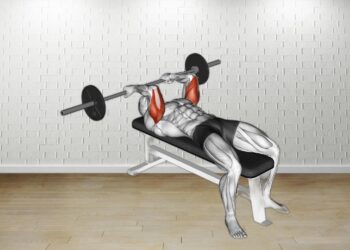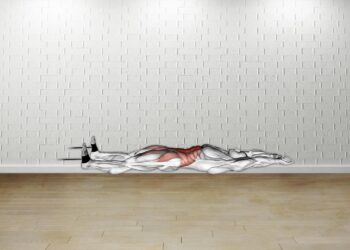The cable twist is an isolation exercise that works the oblique muscles of the core. It’s unique in that it not only helps to strengthen the core muscles but it’s a functional exercise because it’s performed on the feet. This offers better carryover for athletic activities and overall functionality because it mimics real-life movement.
Plus, a stronger core improves lifting performance that will help you to progress faster and more effectively. In this guide, we’ve explained how to do the cable twist, with tips, variations, and some information on how to include it in your training routine.
Here’s a guide to the cable twist…
Related article: Train Your Obliques For A Killer Core
Muscles Worked
A few different muscles are involved in this exercise.
Obliques
The obliques consist of the internal and external obliques and are considered core muscles. These muscles are located on either side of the rectus abdominis (six-pack muscles), and are responsible for trunk rotation and assist with lateral trunk flexion.
Level Up Your Fitness: Join our 💪 strong community in Fitness Volt Newsletter. Get daily inspiration, expert-backed workouts, nutrition tips, the latest in strength sports, and the support you need to reach your goals. Subscribe for free!
Iliopsoas
The iliopsoas is the primary hip flexor made up of the major and minor psoas muscles and the iliacus muscle. It’s important for several functions such as supporting posture, running, walking, and the two muscles can act separately to stabilize and facilitate specific movement.
Tensor Fasciae Latae
The tensor fasciae latae is located in the lateral part of the thigh. It works with other muscles to assist in the facilitation of movement and stabilization of the hips and knee.
How To Do The Cable Twist
- Attach the single grip handle to a cable pulley about hip level.
- Stand sideways to the cable pulley just off the center and at an angle with feet pointed slightly away from it in a shoulder-width stance.
- Grip the handle with the nearest hand, then interlock the other hand with that hand on the handle.
- Tighten your core and then rotate inward and away from the machine so that you’re facing in the opposite direction.
- Allow yourself to return to the starting position under control by rotating back toward the machine.
- Once again, rotate yourself inward and away from the machine so that you’re really activating the obliques.
- Repeat for the desired reps and switch sides.
Here’s a video example…
Cable twist tips
- Keep your core tight during the movement for optimal muscle stimulation.
- Avoid performing the reps too quickly; focus on engaging the target muscles.
- Don’t use maximal weight for this exercise as this defeats the purpose of the exercise and is dangerous.
- You can maintain a slight bend in your elbows.
- Don’t stand too narrow or too wide as you find to have good balance and moveability.
4 Variations/Alternatives
The cable twist is a fantastic oblique exercise that is also functional as you’re on your feet and in a position that’s closer to a realist movement situation. But it’s just one variation of many that can effectively target this muscle group and offer the same benefits. Here are four variations/alternatives that we highly recommend to improve your core development.
Cable wood chop
One of the best cable oblique exercise variations is the wood chop that may even be better than the cable twist. The reason being is that it actually simulates the chopping of wood, and therefore really engages the core, but it also helps you to develop movement precision. Incorporate this variation during your core training.
Level Up Your Fitness: Join our 💪 strong community in Fitness Volt Newsletter. Get daily inspiration, expert-backed workouts, nutrition tips, the latest in strength sports, and the support you need to reach your goals. Subscribe for free!
Tall kneeling cable twist
Try the cable twist on your knees to really force the core muscles to engage. By taking the legs out of the movement, you may be more aware of the need to really engage the core.
Cable side crunch
The cable side crunch is a standing oblique crunch that is an excellent alternative to the cable twist because you simply can’t go wrong with a crunch. Not to mention, using cables keeps constant tension on the muscles and it’s just a “feel good” exercise.
Cable Russian twist
The cable Russian twist performs a similar action as the cable twist but it’s performed while lying on a stability or exercise ball. It’s arguably the better exercise for promoting total-body stability but it also seems to engage the core muscles to a greater degree compared to the more basic cable twist.
How To Incorporate The Cable Twist Into Your Training Routine
The cable twist is a good exercise to include as part of your core training, although, it’s also effective as an accessory exercise or as an inclusion in any of your main workouts.
But if you use it in your core workouts, we recommend doing it near the end of your routine after you’ve completed your more challenging core exercises. It’s always ideal to do the more difficult exercises first in your workouts when you’re fresh and have the most strength and energy to give your best effort. Because as most would agree, it’s the hard exercises that bring the most reward (when done properly of course).
So for example, the ideal core workout would consist of some type of hanging leg raises or leg lifts first because they are typically the most challenging due to the heavy weight of the legs. Then, you’d follow this up with an exercise that involves the lower and upper body such as recliner crunches, and then you can add regular crunches, a lying rotational exercise, and then a standing movement such as the cable twist.
Sets/reps
We recommend at least 3 sets of anywhere from 10-20 reps for the cable twist as this is really all that you need if done with enough intensity and good form, using a full range of motion. You can vary your reps based on the weight used for a given workout and you should be good to go.
Wrapping Up
The cable twist is a good, functional exercise that anyone can do safely and effectively. You don’t have to handle heavy weights and it’s convenient and easy to setup. Plus, there’s nothing really complex about it. You’re simply using your core muscles to twist your body in one direction and this alone offers tons of applicable benefits to overall performance.
Interested in measuring your progress? Check out our strength standards for Side Crunch, Russian Twist, Hanging Leg Raise, and more.








